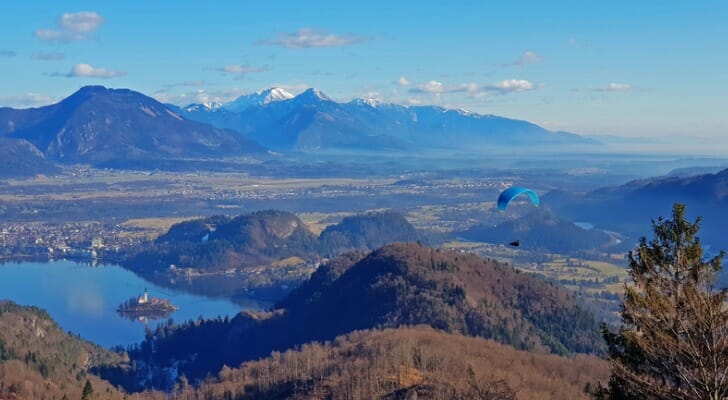Slovenia, a country known for its castles and caves as well as a high number of bee-keeping aficionados, shares borders with Italy, Austria, Croatia and Hungary. While it isn’t one of the most popular retirement destinations, this predominantly Roman Catholic nation of some 2.1 million has a lot to offer expatriates looking for a quiet retirement, either along the shores of the Adriatic Sea, in the mountains or one of its cities. If you’re wondering how to retire in this central European country.
Consider working with a financial advisor who understands your goals of retiring abroad.
Cost of Living and Housing in Slovenia
Slovenia is generally less expensive than the U.S. For example, according to Numbeo, a cost-of-living database, consumer prices in the U.S. are about 45% higher than in Slovenia, and rent prices are on average 190% higher in the U.S. Therefore, your retirement budget may stretch a lot further in Slovenia than in the U.S.
Ljubljana is one of the most popular cities in Slovenia for retirees. If you choose to live in Ljubljana, you can expect a one-bedroom apartment in the city center to cost about $740 per month. If you want to live outside the center, the same apartment will cost about $618 per month. In contrast, a one-bedroom in New York City will cost from approximately $2,900 to $3,900 per month, depending on where you choose to live in the city.
Visas and Permits Required to Retire in Slovenia
Slovenia does not have a designated retirement visa for non-EU citizens. However, U.S. citizens can get a one-year temporary residence permit to Slovenia before leaving home. This permit is renewable annually, and after five years of living in Slovenia with the temporary residence permit, you can apply for permanent residency.
To apply for a temporary residence visa, you must prove that you have a monthly income equal to Slovenia’s basic monthly income. This amount changes but is currently around $1,000 per month. You will also be required to submit a copy of your bank statements among other financial documents. You can apply for your temporary residence visa via the Slovene embassy or the Slovene Ministry of Foreign Affairs.
Cost of Healthcare in Slovenia

As part of the European Union, Slovenia has good healthcare. Numbeo ranks it No. 46 out of 93 countries, and Photius ranks it at No. 38. Slovenia has a public healthcare system and includes private healthcare and physician access as part of public health insurance.
All residents of Slovenia who pay taxes are covered by the country’s compulsory health insurance scheme. The public health scheme also covers retirees. Many people choose to purchase private health insurance to cover visits to private physicians and pharmacies.
The cost of health insurance will vary but typically costs less than $450 per month. Visits to doctors are typically fully covered by insurance, and prescriptions are available at about 10% of the cost of prescriptions in the U.S., depending on the drug.
Taxes in Slovenia
Slovenian residents are taxed on their global income. Income taxes range from 16% to 50%, depending on a person’s income. Capital gains tax is 25% in Slovenia. Therefore, if you earn an income in Slovenia or buy and sell assets, you will be taxed.
To avoid being taxed in both Slovenia and the U.S., you should work with an accountant or financial professional who understands both countries’ tax codes. This will help you prevent being taxed by both governments on your retirement income.
Is Slovenia Safe?
Slovenia is among the safest countries in the world. The 2022 Gallup Law and Order report says there are only five other countries in which people feel safer walking alone. According to the U.S. Department of State, the capital city of Ljubljana is a low-threat location for crime. Although many travelers don’t encounter crime, popular tourist locations can experience non-violent petty crime.
It’s important to note; that crimes can take place anywhere. However, travel throughout Slovenia is safe, and there are no areas you should avoid when touring. The superior healthcare system makes Slovenia a safe country to retire to as access to quality medical attention is readily available.
Bottom Line
Slovenia, a heavily Roman Catholic nation, is a beautiful and safe country to spend your retirement. Although Slovenian is the main language spoken in this country, many people, especially younger people and urban residents, can speak English, too. The taxes in Slovenia are similar to those in the U.S., but the cost of living is significantly lower. Therefore, you can live a similar lifestyle as you would in the U.S. at a much lower cost.
Tips on Affording Retirement
- It can be challenging to plan your retirement, especially if you would like to move abroad. A financial advisor can also help you understand the finer points of relocating, including the tax implications. Finding a financial advisor doesn’t have to be hard. SmartAsset’s free tool matches you with vetted financial advisors who serve your area, and you can have a free introductory call with your advisor matches to decide which one you feel is right for you. If you’re ready to find an advisor who can help you achieve your financial goals, get started now.
- The minimum monthly income required to retire in Slovenia is about $1,000 per month. For many people, this is equal to or less than their monthly Social Security benefit. You can estimate your benefit amount with this Social Security calculator.
Photo credit: ©iStock.com/Ababsolutum, ©iStock.com/Alenka Vujkovac, ©iStock.com/MikeMareen

